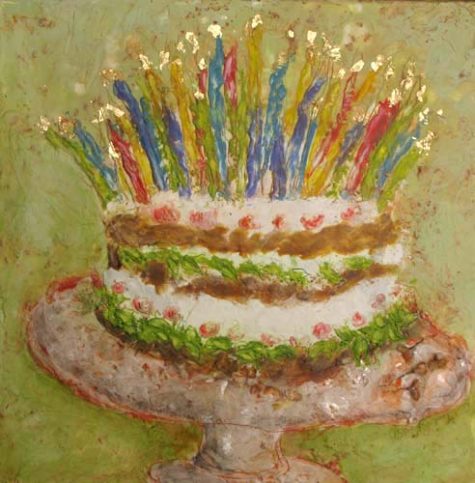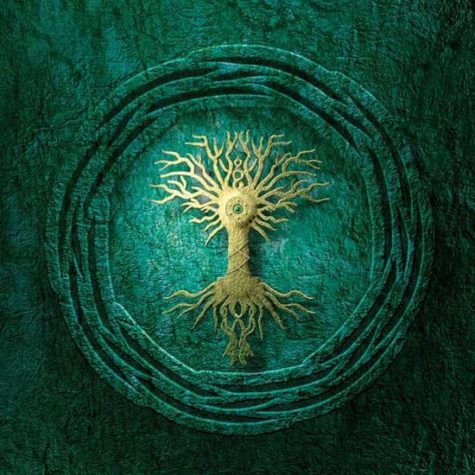Birthdays
An ancient Greek custom of honoring Artemis’s birthday with a Full Moon cake is still seen today in our birthday cakes. The Greeks even put lighted candles on the Moon cake.
To honor the birthday of the goddess Artemis, bake or buy a small cake or cupcake. In Moon Magick, D J Conway recommends this ritual be performed on the night of the March crescent – it feels more appropriate to me to do the ritual on the night before or the night of her actual day.
Dress in nice clothes as if you were entertaining a friend. Cover your altar or spiritual place with a nice cloth. Put the cake with a small candle on it in the middle of the altar. Set pictures or statues of animals around it for decoration. Artemis loves cats of all kinds, deer, and all wild animals. Set a glass of juice or wine next to the cake.
Take a sip of juice and light the candle. Sing “Happy Birthday” to the goddess if you wish – or simply and sincerely wish her a happy birthday. Then say:
Lady of Wild Things, Moon Huntress,
Mistress of magick and enchantment,
I chant your lovely name for protection.
Artemis! Artemis! Artemis!
I whisper your praises to the Full Moon.
Cradle my restless, worn spirit
In the secret places of your deep woodlands.
Renew my life, swift Artemis.
Cut yourself a piece of the cake and eat it. Drink the juice. Tell the goddess why you need protection. When you are finished, thank her for the help that will come. Put the remainder of the cake outside as a feast for the birds and animals.
Note: I think it’s nice to simply honor the gods without necessarily asking for anything in return. A powerful blessing could be as simple as a recitation of her names and titles. For example:
Hail Mistress of the Animals
My heart opens to the Moon Huntress
Blessings to She of the Wild
Love to the Most Beautiful
Praise to the Lady of Many Shrines and Many Cities
I Worship the Lady of the Wild Mountains
Adoration to the Opener of the Womb
Gratitude to the Mistress of Magic and Enchantment
Artemis! Artemis! Artemis!
For maximum effect – repeat each line three times.
Another note: This ritual can be tweaked for use for any god or goddess on his/her day. Simply find an appropriate invocation – or rewrite the one above to fit, and decorate the altar with whatever might please your chosen deity.
Sources: This post was put together by Shirley Twofeathers for Gypsy Magic, and was moved to its new home here at shirleytwofeathers.com you may repost and share without karmic repercussions only if you give me credit and a link back to this website. Blessed be.
The seventh day of the Chinese New Year, traditionally known as Rénrì (人日, the common man’s birthday), is the day when everyone grows one year older. In some overseas Chinese communities in Southeast Asia, such as Malaysia and Singapore, it is also the day when tossed raw fish salad, yusheng, is eaten for continued wealth and prosperity.
This day is filled with omens about human fate. For example, any person or animal born on this day is considered doubly blessed and destined for prosperity. So, consider taking out a divination tool today and seeing what fate holds for you.
In Chinese mythology, Nüwa is the goddess who created the world. She created the animals on different days, and human beings on the seventh day after the creation of the world. The order of creation is as follows:
- First of zhengyue: Chicken
- Second of zhengyue: Dog
- Third of zhengyue: Boar
- Fourth of zhengyue: Sheep
- Fifth of zhengyue: Cow
- Sixth of zhengyue: Horse
- Seventh of zhengyue: Human.
Hence, Chinese tradition has set the first day of zhengyue as the “birthday” of the chicken, the second day of zhengyue as the “birthday” of the dog, etc. And the seventh day of zhengyue is viewed as the common “birthday” of all human beings.
To generate Nüwa’s luck or organizational skills in your life, make and carry a clay Nüwa charm. Get some modeling clay from a toy store (if possible, choose a color that suits your goal, like green for money). If you can’t get clay, bubblegum will work, too. Shape this into a symbol of your goal, saying:
From Nüwa blessings poured,
Luck and order be restored.
Renri is the day, when all common men are growing a year older and the day is celebrated with certain foods according to the origin of the people. The ingredients of the dishes have a symbolic meaning and they should enhance health.
To honour Nüwa’s creation of animals either vegetable dishes will be eaten or a raw fish and vegetable salad called yusheng. Yusheng literally means “raw fish” but since “fish (鱼)” is commonly conflated with its homophone “abundance (余)”, Yúshēng (鱼生) is interpreted as a homonym for Yúshēng (余升) meaning an increase in abundance. Therefore, yusheng is considered a symbol of abundance, prosperity and vigor.
Almost no Chinese celebrate on this day. Some people just eat potatoes with angel hair noodle. The long noodle stands for longevity. In the past, seven vegetables which can repel the evil spirits and sickness away were eaten. They are as follows:
- Celery, Shepherd’s Purse Spinach, Green Onion, Garlic, Mugwort and Colewort
Ancient Chinese had a tradition of wearing head ornaments called rensheng, which were made of ribbon or gold and represented humans. People also climbed mountains and composed poems. Emperors after the Tang dynasty granted ribbon rensheng to their subjects and held festivities with them. If there were good weather on Renri, it was considered that people will have a year of peace and prosperity.
Fireworks and huapao are lit, so Renri celebrates the “birthday” of fire as well.
Since the first days of zhengyue are considered “birthdays” of different animals, Chinese people avoid killing the animals on their respective birthdays and punishing prisoners on Renri.
Nowadays in zhengyue, Renri is celebrated as part of the Chinese New Year. Chinese people prepare lucky food in the new year, where the “seven vegetable soup,” “seven vegetable congee” and “jidi congee” are specially prepared for Renri. Malaysian and Singaporean Chinese use the “seven-colored raw fish” instead of the “seven vegetable soup”.
In Japan, Renri is called Jinjitsu. It is one of the five seasonal festivals. It is celebrated on January 7. It is also known as Nanakusa no sekku, “the feast of seven herbs”, from the custom of eating seven-herb kayu to ensure good health for the coming year.
The celebration of the feast in Japan was moved from the seventh day of the first lunar month to the seventh day of January during the Meiji period, when Japan adopted the Gregorian calendar.
Sources: 365 Goddess and wikipedia
 In Greek tradition, the Goddess Mnemosyne gave birth to the Muses today (June 14) – the nine creative spirit children that give our lives so much beauty, song, stories, tradition, humor, dance, and sacred music. For a magickal celebration here is something from A Daily Guide to the Magic and Inspiration of the Goddess.
In Greek tradition, the Goddess Mnemosyne gave birth to the Muses today (June 14) – the nine creative spirit children that give our lives so much beauty, song, stories, tradition, humor, dance, and sacred music. For a magickal celebration here is something from A Daily Guide to the Magic and Inspiration of the Goddess.
- Themes: Creativity; Knowledge; History; Art
- Symbols: Fountains; Springs; the Number Nine
- Presiding Goddess: Mnemosyne
About Mnemosyne:
Greeks sometimes worshiped Mnemosyne in the form of a spring, alluding to her profuse, flowing energy. Mnemosyne means “memory.” Remembrance is this goddess’s gift to us, memories of all the wonderful moments of our lives.
To do today:
Absolutely anything thoughtful, creative, or inspiring will grab Mnemosyne’s attention and encourage her participation in your day. Try donning a unique combination of clothing that really motivates you to do your best, or something that provokes fond memories from the past. Wear an aroma that arouses your inventive nature or cognitive abilities (jasmine and rosemary are two good choices, respectively).
If there are special arts that you’ve learned from family or friends, celebrate them today. Hum that little ditty from your childhood, dust off that neglected craft item, try those recipes, listen to old songs, and let Mnemosyne fill your hours with the encouragement that comes from fond “musings.”
January 25, the birthday of Scotland’s most famous poet, Robert Burns (1759-1796), has become an occasion for Scots all over the world to gather together in his honor. A Burns Night supper usually includes haggis, a traditional dish of the heart, lungs, and liver of a sheep or calf minced with suet, onions, oatmeal, and seasonings. Burns’s words: “Hail Great Chieftan o’ the Puddin-race!” greets the dish’s entry into the room. Men wear kilts and women their tartan sashes, and the evening’s celebration includes reading Burns’s poems and singing his songs, ending with one of his most famous, “Auld Lang Syne.
Found at Almanac.com
The Death of Tammuz also known as Noosardel (sprinkling water on the path of God) was another Yultide holiday celebrated with an early morning worship service, a tree, and a burning log.
“Then he brought me to the door of the gate of the Lord’s house
which was toward the north; and, behold,
there sat women weeping for Tammuz.”
~Ezekiel 8:14
In the legend, Tammuz dies young and his birth is honored on his birthday which coincided with the Winter Solstice. This was celebrated on or around December 21st. Part of the ritual involved cutting down a young evergreen tree as a way of commemorating the premature death of Tammuz. Along with this, the Babylonians would also burn a Yala (Yule) log, called “the log of the son.” It was burned in the fire to symbolize the death of Tammuz. The next day the evergreen tree would be decorated with silver and gold. The log that was burned was now alive again as the Tammuz tree.
“..for one cutteth a tree out of the forest,
the work of the hands of the workman, with the ax;
They deck it with silver and with gold;
they fasten it with nails and with hammers,
that it move not.”
~Jeremiah 10:3-4
Found at: Assyrian Voice
 Mawlid (Arabic: مَولِد النَّبِي , “Birth of the Prophet”) is the observance of the birthday of the Islamic prophet Muhammad which is celebrated often on the 12th day of Rabi’ al-awwal, the third month in the Islamic calendar. The 12th Day of Rabi’ al-awwall is the most popular date from a list of many dates that are reported as the birth date.
Mawlid (Arabic: مَولِد النَّبِي , “Birth of the Prophet”) is the observance of the birthday of the Islamic prophet Muhammad which is celebrated often on the 12th day of Rabi’ al-awwal, the third month in the Islamic calendar. The 12th Day of Rabi’ al-awwall is the most popular date from a list of many dates that are reported as the birth date.
In some countries, such as Egypt and Sudan, Mawlid is used as a generic term for the celebration of birthdays of local Sufi saints and not only restricted to the observance of the birth of Muhammad. Around 3,000 Mawlid celebrations are held each year. These festivals attract an international audience, with the largest one in Egypt attracting up to three million people honoring Ahmad al-Badawi, a local 13th-century Sufi saint.
Mawlid is recognized as a national holiday in most of the Muslim-majority countries of the world except Saudi Arabia and Qatar.
Along with being referred to as the celebration of the birth of Muhammad, the term Mawlid also refers to the ‘text especially composed for and recited at Muhammad’s nativity celebration’ or “a text recited or sung on that day”.
The date of Muhammad’s birth is a matter of contention since the exact date is unknown and is not definitively recorded in the Islamic traditions. Among the most recognizable dates, Sunni Muslims believe the date to have been on the twelfth of Rabi’ al-awwal, whereas Shi’a Muslims believe the date to have been on the seventeenth.
Among Muslim scholars, the legality of Mawlid “has been the subject of intense debate” and has been described as “perhaps one of the most polemical discussions in Islamic law”. Traditionally, most Sunni and nearly all of the Shia scholars have approved of the celebration of Mawlid, while Wahhabi and Ahmadiyya scholars oppose the celebration.
Examples of historic Sunni scholars who permitted the Mawlid include the Shafi’i scholar Al-Suyuti (d 911 A.H.) who stated that:
My answer is that the legal status of the observance of the Mawlid – as long as it just consists of a meeting together by the people, a recitation of apposite parts of the Qur’an, the recounting of transmitted accounts of the beginning of (the biography of) the Prophet – may God bless him and grant him peace – and the wonders that took place during his birth, all of which is then followed by a banquet that is served to them and from which they eat – is a good innovation (bid’a hasana), for which one is rewarded because of the esteem shown for the position of the Prophet – may God bless him and grant him peace – that is implicit in it, and because of the expression of joy and happiness on his – may God bless him and grant him peace – noble birth.
The Shafi’i scholar Ibn Hajar al-Asqalani (d 852 A.H.) too approved of the Mawlid and states that:
As for what is performed on the day of the Mawlid, one should limit oneself to what expresses thanks to God, such as the things that have already been mentioned: [Qur’anic] recitation, serving food, alms-giving, and recitation of praise [poems] about the Prophet – may God bless him and grant him peace – and asceticism which motivate people to perform good deeds and act in view of the next world.
Mawlid is celebrated in almost all Islamic countries, and in other countries that have a significant Muslim population, such as India, the United Kingdom, Nepal, Sri Lanka, France, Germany, Italy, Russia and Canada. The only exceptions are Qatar and Saudi Arabia where it is not an official public holiday and is forbidden.
Often organized in some countries by the Sufi orders, Mawlid is celebrated in a carnival manner, large street processions are held and homes or mosques are decorated. Charity and food is distributed, and stories about the life of Muhammad are narrated with recitation of poetry by children. Scholars and poets celebrate by reciting Qaṣīda al-Burda Sharif, the famous poem by 13th-century Arabic Sufi Busiri.
A general Mawlid appears as “a chaotic, incoherent spectacle, where numerous events happen simultaneously,all held together only by the common festive time and space”. These celebrations are often considered an expression of the Sufi concept of the pre-existence of Muhammad . However,the main significance of these festivities is expression of love for Muhammad.
During Pakistan’s Mawlid the day starts with a 31-gun salute in federal capital and a 21-gun salute at the provincial capitals and religious hymns are sung during the day.
In many parts of Indonesia, the celebration of the Mawlid al-nabi “seems to surpass in importance, liveliness, and splendour” the two official Islamic holidays of Eid ul-Fitr and Eid al-Adha.
In Qayrawan, Tunisia, Muslims sing and chant hymns of praise to Muhammad, welcoming him in honor of his birth.Also, generally in Tunisia, people usually prepare Assidat Zgougou to celebrate the Mawlid.
Assidat Zgougou is a Tunisian dessert originally made out of honey, smen and semolina, that dish is now known as “εasida turki”
The lower layer is made of the grains of Aleppo pines “zgougou.” The grains are cleaned, then they are ground in water and sieved to very small sizes. The resulting juicy substance is then mixed with wheat flour and/or starch depending on the recipe. Sometimes concentrated milk is added. Then everything is cooked at low heat while stirred. Powdered sugar is added gradually as the mixture thickens, giving rise to a grayish-brown color.
The result is poured hot in a bowl and cover in a white cream made out of milk, starch, sugar, eggs and a bit of orange blossom essence then decorated with almonds and other seeds and nuts, whole or ground, and small candy.
It is also possible to make an assida out of other nuts instead of the allepo pine’s grains, like hazelnuts, chestnuts, pistachio or others, but in that case it won’t be assidat zgougou, but assidat of what was used.
Among non-Muslim countries, India is noted for its Mawlid festivities. The relics of Muhammad are displayed after the morning prayers in the Indian state of Jammu and Kashmir at the Hazratbal Shrine, where night-long prayers are also held.
Most Shia scholars believe the 17th day of Rabi’ al-awwal is the birthday of the Muhammad, and most Sunni scholars believe that is the 12th day of Rabi’ al-awwal. This issue led to assigning these days (12-17 Rabi’ al-awwal) as Unity Week by Islamic Republic of Iran to respect both viewpoints. So scholars and followers of these two sects emphasize on common ground against the common enemies, and an International Islamic Unity Conference is hosted each year.
Source: Wikipedia
Related Content:







